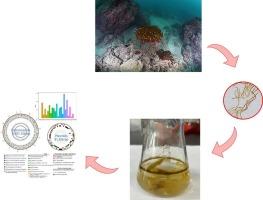珊瑚礁生态系统中一种新型蓝藻的基因组复杂性和进化多样性
IF 4.5
2区 生物学
Q1 BIOTECHNOLOGY & APPLIED MICROBIOLOGY
Algal Research-Biomass Biofuels and Bioproducts
Pub Date : 2025-08-30
DOI:10.1016/j.algal.2025.104280
引用次数: 0
摘要
形成异细胞的蓝藻在珊瑚礁生态系统的碳、氧和氮循环中起着关键作用。尽管它们具有生态意义和生物医学潜力,但我们对珊瑚礁相关蓝藻的了解仍然有限。本研究描述了一种从南海热带珊瑚礁分离出来的异细胞蓝藻Aliinostoc maniaoense sp. nov.。从形态上看,麻麻属植物表现出结构松散的细丝,带有气囊的运动龙头和圆柱形或不规则形状的运动龙头,这是其与其他属植物的区别。系统发育分析证实了它在Aliinostoc中的位置,并显示了与先前描述的物种的显著遗传差异。基因组分析显示一个完整的固氮基因簇,其系统发育表明古代重排或水平获取,可能反映了生态适应和生物固氮在营养贫乏的珊瑚礁栖息地的选择优势。此外,A. maniaoense具有异常多的核糖体操纵子,在16S23S内部转录间隔器(ITS)二级结构上存在显著差异,突出了蓝藻中基于ITS的分类的复杂性。体外生物活性测定显示出对几种癌细胞系的有效细胞毒作用,强调了其生物医学潜力。此外,基因组挖掘揭示了nocuolin A和异囊糖脂的生物合成基因簇以及几种未表征的次级代谢途径,这表明有前景的生态和生物技术应用。这些发现扩大了我们对珊瑚礁蓝藻多样性的理解,并强调了整合形态学,分子和基因组方法对准确的物种分类和功能表征的重要性。本文章由计算机程序翻译,如有差异,请以英文原文为准。

Genomic complexity and evolutionary diversification of a novel cyanobacterium from coral reef ecosystems
Heterocyte-forming cyanobacteria play a critical role in carbon, oxygen, and nitrogen cycling in coral reef ecosystems. Despite their ecological significance and biomedical potential, our understanding of reef-associated cyanobacteria remains limited. This study described Aliinostoc maniaoense sp. nov., a novel heterocyte-forming cyanobacterium isolated from a tropical coral reef in the South China Sea. Morphologically, A. maniaoense exhibited filaments with loose structural arrangement, gas vesicle-bearing motile hormogonia, and cylindrical or irregularly shaped akinetes, distinguishing it from other members of the genus. Phylogenetic analyses confirmed its placement within Aliinostoc and demonstrated significant genetic divergence from previously described species. Genomic analysis revealed a complete nitrogen fixation gene cluster, whose phylogeny suggested ancient rearrangement or horizontal acquisition, likely reflecting ecological adaptation and the selective advantage of biological nitrogen fixation in nutrient-poor coral reef habitats. Additionally, A. maniaoense possessed an unusually high number of ribosomal operons, with notable variations in 16S![]() 23S internal transcribed spacer (ITS) secondary structures, highlighting the complexity of ITS-based taxonomy in cyanobacteria. In vitro bioactivity assays demonstrated potent cytotoxic effects against several cancer cell lines, underscoring its biomedical potential. Moreover, genome mining revealed biosynthetic gene clusters for nocuolin A and heterocyst glycolipids along with several uncharacterized secondary metabolite pathways, suggesting promising ecological and biotechnological applications. These findings expanded our understanding of cyanobacterial diversity in coral reefs and emphasized the importance of integrating morphological, molecular, and genomic approaches for accurate species classification and functional characterization.
23S internal transcribed spacer (ITS) secondary structures, highlighting the complexity of ITS-based taxonomy in cyanobacteria. In vitro bioactivity assays demonstrated potent cytotoxic effects against several cancer cell lines, underscoring its biomedical potential. Moreover, genome mining revealed biosynthetic gene clusters for nocuolin A and heterocyst glycolipids along with several uncharacterized secondary metabolite pathways, suggesting promising ecological and biotechnological applications. These findings expanded our understanding of cyanobacterial diversity in coral reefs and emphasized the importance of integrating morphological, molecular, and genomic approaches for accurate species classification and functional characterization.
求助全文
通过发布文献求助,成功后即可免费获取论文全文。
去求助
来源期刊

Algal Research-Biomass Biofuels and Bioproducts
BIOTECHNOLOGY & APPLIED MICROBIOLOGY-
CiteScore
9.40
自引率
7.80%
发文量
332
期刊介绍:
Algal Research is an international phycology journal covering all areas of emerging technologies in algae biology, biomass production, cultivation, harvesting, extraction, bioproducts, biorefinery, engineering, and econometrics. Algae is defined to include cyanobacteria, microalgae, and protists and symbionts of interest in biotechnology. The journal publishes original research and reviews for the following scope: algal biology, including but not exclusive to: phylogeny, biodiversity, molecular traits, metabolic regulation, and genetic engineering, algal cultivation, e.g. phototrophic systems, heterotrophic systems, and mixotrophic systems, algal harvesting and extraction systems, biotechnology to convert algal biomass and components into biofuels and bioproducts, e.g., nutraceuticals, pharmaceuticals, animal feed, plastics, etc. algal products and their economic assessment
 求助内容:
求助内容: 应助结果提醒方式:
应助结果提醒方式:


